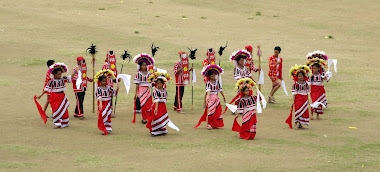The name Higaonon is derived from three Bukidnon words which are “higa” or living, “goan” or mountain and “onon” or people. And it goes to say that Higaonon means people living in the mountain or people living in the wilderness. Another version of the origin of the word is that “higa” means coastal plain, and “goan” a verb that means to ascend to the mountains. This suggests that Higaonons were once living in the coastal areas who later moved to the mountains.
Before the
Spaniards came to this place which is now called Cagayan de Oro, there was a
Higaonon village called Himologan which was along the river called Cagaiang.
Its leader was Datu Salangsang. During that time Islam was already the
widespread religion especially in the western and south western parts of
Mindanao. A Muslim leader named Sultan Kudarat from Cotabato was the paramount
ruler in great parts of Mindanao, and his area of influence reached as far as
the Himologan village. Despite the predominance of the Islamic faith, Datu
Salangsang and his people remained polytheistic animists although they had to
pay tribute to Sultan Kudarat for protection.Higaonon Tribal Council members during fiesta parade
In 1622 recollect
missionaries Fray Francisco de la Madre de Dios and Fray Juan de San Nicolas with
the help of Magdalena Bacuya, who was the Christianized grandmother of Datu
Salangsang, sailed from Butuan to Himologan. Reaching there, they wanted to
Christianize the natives, but realizing that doing so might provoke a reprisal
from the Sultan and might put the village at risk of a Moro attack, the priests
withheld their action. They went back to Butuan to seek help, and Fray Agustin
de San Pedro, later known as El Padre Capitan went to Himologan. After a brief
stay there, he decided to move the village inhabitants to a promontory which is
now the site of Saint Augustine Cathedral and Gaston Park. El Padre Capitan trained
the natives on fighting skills and built a wall fortification which he called “Fuerza
Real de San Jose” to repel Moro attacks.
Over the
years, migration of people particularly from the Vizayas such as Cebu and Bohol
have shaped the present demographic character of Cagayan de Misamis, now
Cagayan de Oro which is a largely Christian and Cebuano speaking city. There
are also considerable number of minorities such as Chinese, Maranao and people
coming from other parts of the Philippines and Mindanao. Higaonons who mostly
live in the hinterlands of the city call people living in the lowlands as “Dumagats”.
The Higaonons have considerable population in barangays such as LumbIa, Besigan,
Bayanga, Tumpagaon, FS Catanico, Tignapuluan, Pagalungan, Tablon, Dansolihon, Tagpangi,
Cugman, Mambuaya. Taglimao, San Simon, Tuburan and Pigsag-an.
Higaonons
speak dialect which is different from the mainstream Cebuano. Their dialect
which is called “Binukid” is a variant of the Manobo dialect. It is not
intelligible with Cebuano, Maranao or dialects of other ethnic groups living in
the surrounding areas. Although most Higaonons are conversant with Cebuano,
their dialect is not intelligible to Cebuanos or to Maranaos. With the passing
of time, younger Higaonons have become more fluent with Cebuano than the
dialect of their parents. And there is a danger that the succeeding generations
might lost the dialect of their ancestors due to their adaptation of the
language spoken by the mainstream population of Northern Mindanao.
Although
the Higaonons have embraced the Christian faith, they retained some traces of
their animistic beliefs and practices. Some still invoke the help of nature
spirits in activities such as planting, hunting and other endeavors. Higaonons
subsist mainly on farming as their means of livelihood. They also engaged in
gold panning and fishing in the river, and on hunting games in the wild. Parts
of their social, cultural, political and other activities revolve around the Datu
who is a respected person in a community who acts as a leader, a counsellor, a dispute
mediator or even as a medicine man.
The
Higaonons are gentle and friendly people who are also fierce when provoked. They
are an indigenous people in the city who remain proud and loyal to their
traditions and cultures despite the political, social and demographic changes
that have taken place with the passing of time.



No comments:
Post a Comment